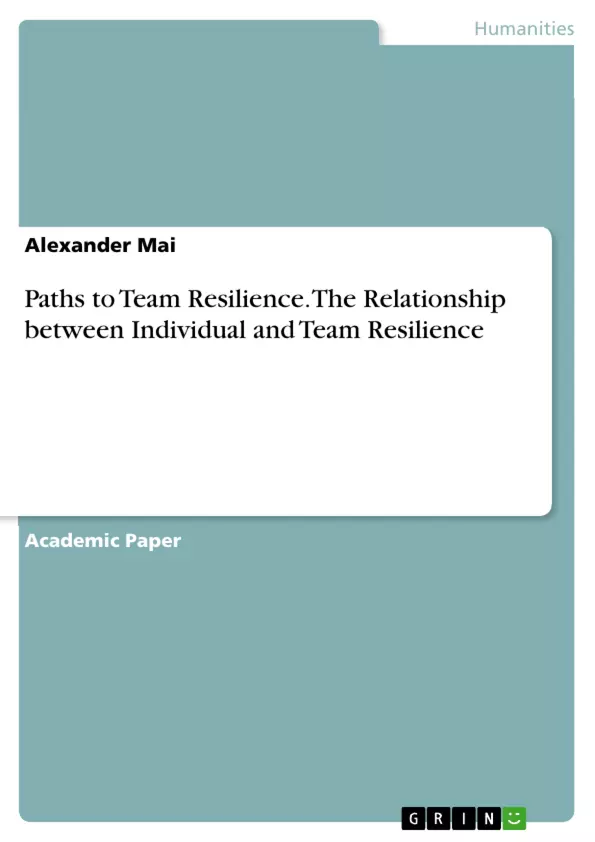Resilience is the ability of a person or an organization to resist adverse events. This paper examines the relationship between individual and team resilience. The three mediators that were chosen to examine the relationship between individual and team resilience in more detail are "meaning and purpose", "self-awareness" and "psychological response to stress". The three mediators were chosen because, at first glance, they are not the most intuitive variables to expect in linking individual and team resilience and because there is not yet adequate research related to the variables. In the proposed cross-sectional study, the authors use scales that are established in science to measure the different variables. This paper contributes to the research field of resilience through the theoretical analysis and in addition through the proposal of a study for future research. In the paper it is hypothesized that meaning and purpose, self-awareness and psychological response to stress mediate the relationship between individual resilience (IR) and team resilience (TR). The importance and relevance of the proposed study is discussed at the end of the paper.
Inhaltsverzeichnis (Table of Contents)
- Introduction
- Individual Resilience
- Team Resilience
- Mediating Factors
- Meaning and Purpose
- Self-Awareness
- Psychological Response to Stress
- Method
- Study Design
- Participants
- Data Collection
- Data Analysis
- Discussion
- Conclusion
Zielsetzung und Themenschwerpunkte (Objectives and Key Themes)
This paper examines the relationship between individual and team resilience, exploring how individual resilience influences team resilience. It seeks to understand the mediating factors that bridge this connection. The study proposes a cross-sectional research design to investigate these relationships.
- The link between individual and team resilience
- The role of mediating factors in this relationship
- Meaning and purpose as a mediating factor
- Self-awareness as a mediating factor
- Psychological response to stress as a mediating factor
Zusammenfassung der Kapitel (Chapter Summaries)
- Introduction: This chapter provides a general overview of the topic of resilience, highlighting the increasing importance of understanding both individual and team resilience in today's demanding environments. It outlines the research gap regarding the relationship between these two concepts.
- Individual Resilience: This chapter delves into the concept of individual resilience, discussing its definition, development, and measurement. It explores the key protective factors that contribute to individual resilience, such as self-efficacy, self-esteem, and social support.
- Team Resilience: This chapter focuses on the definition and conceptualization of team resilience, highlighting the different perspectives on this construct. It emphasizes the importance of team resilience in navigating workplace adversity and maintaining performance.
- Mediating Factors: This chapter introduces the three mediating factors proposed to explain the relationship between individual and team resilience: meaning and purpose, self-awareness, and psychological response to stress.
- Meaning and Purpose: This chapter explores the role of meaning and purpose in the individual and team context. It examines how finding meaning and purpose can enhance both individual and team resilience.
- Self-Awareness: This chapter delves into the significance of self-awareness in fostering individual and team resilience. It explores how understanding one's own strengths and weaknesses can contribute to effective stress management and coping mechanisms.
- Psychological Response to Stress: This chapter examines the influence of psychological response to stress on both individual and team resilience. It discusses how different coping strategies and stress management techniques can impact resilience levels.
- Method: This chapter outlines the study design, including the participants, data collection methods, and data analysis procedures. It describes the specific scales and measures that will be used to assess the variables.
- Study Design: This chapter provides a detailed description of the research methodology employed in the study. It explains the rationale behind the chosen design and the steps involved in conducting the research.
- Participants: This chapter outlines the characteristics of the participants selected for the study. It describes the target population and the criteria used for participant recruitment.
- Data Collection: This chapter details the data collection procedures, including the instruments used, the data collection process, and the time frame for data collection.
- Data Analysis: This chapter explains the statistical methods that will be used to analyze the collected data. It describes the specific analyses that will be performed to test the hypotheses.
- Discussion: This chapter presents the results of the study and their implications for the understanding of the relationship between individual and team resilience. It discusses the findings in light of existing literature and provides insights into the mediating factors.
Schlüsselwörter (Keywords)
The main keywords and focus topics of the paper are individual resilience, team resilience, stress, self-awareness, and meaning and purpose. The research explores the relationship between individual and team resilience, investigating the mediating roles of these key concepts.
- Arbeit zitieren
- Alexander Mai (Autor:in), 2021, Paths to Team Resilience. The Relationship between Individual and Team Resilience, München, GRIN Verlag, https://www.grin.com/document/1297683



